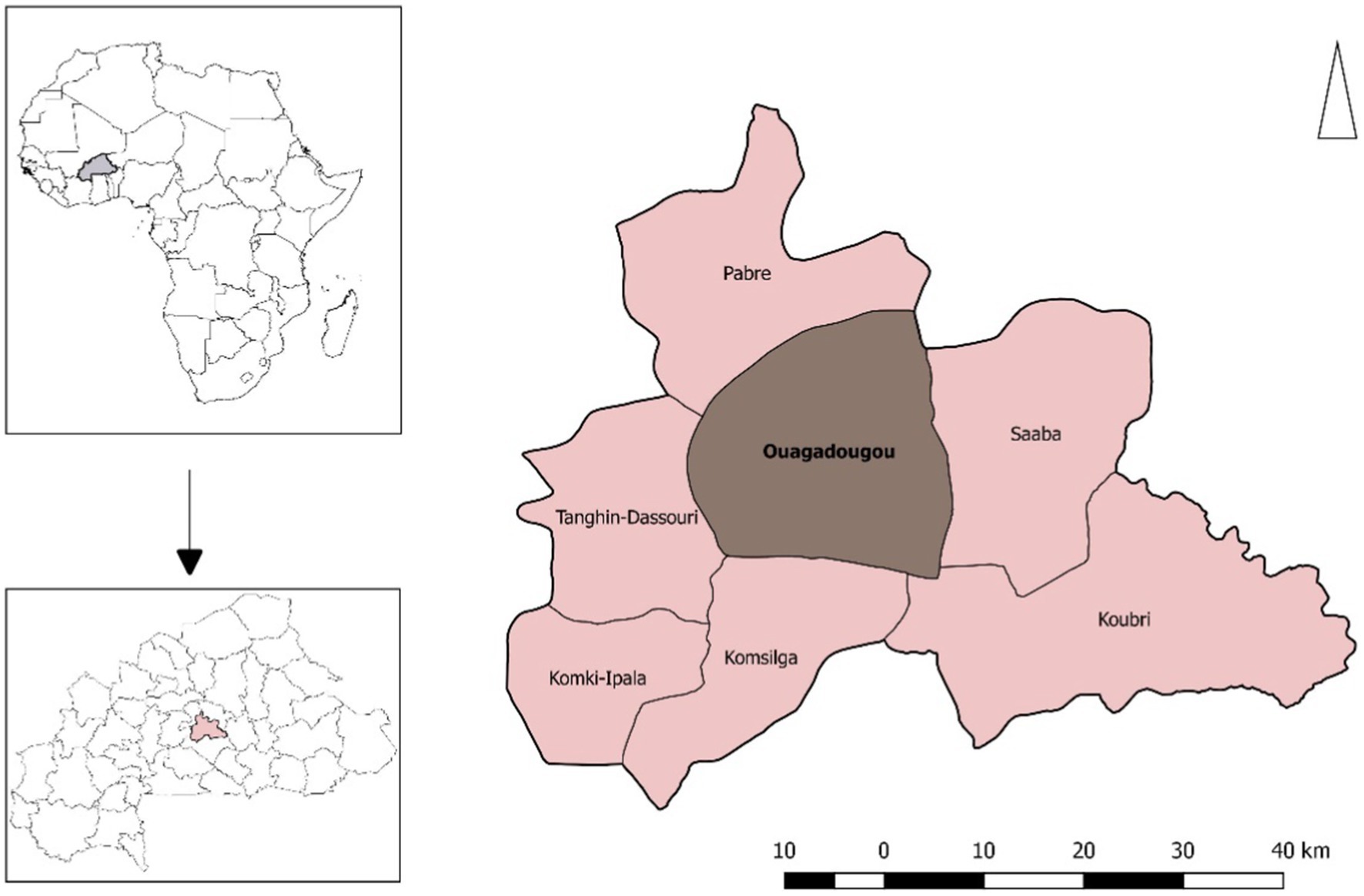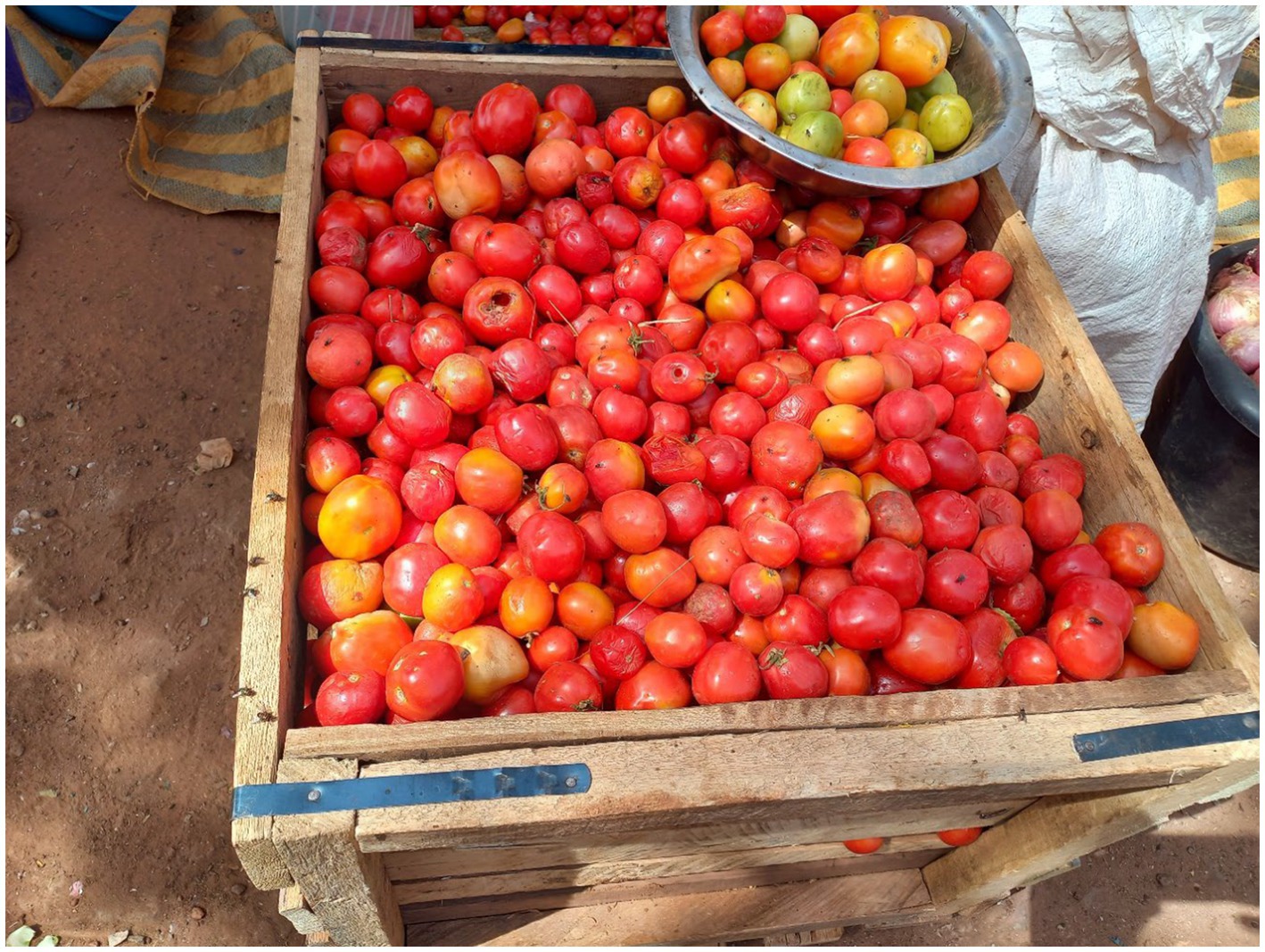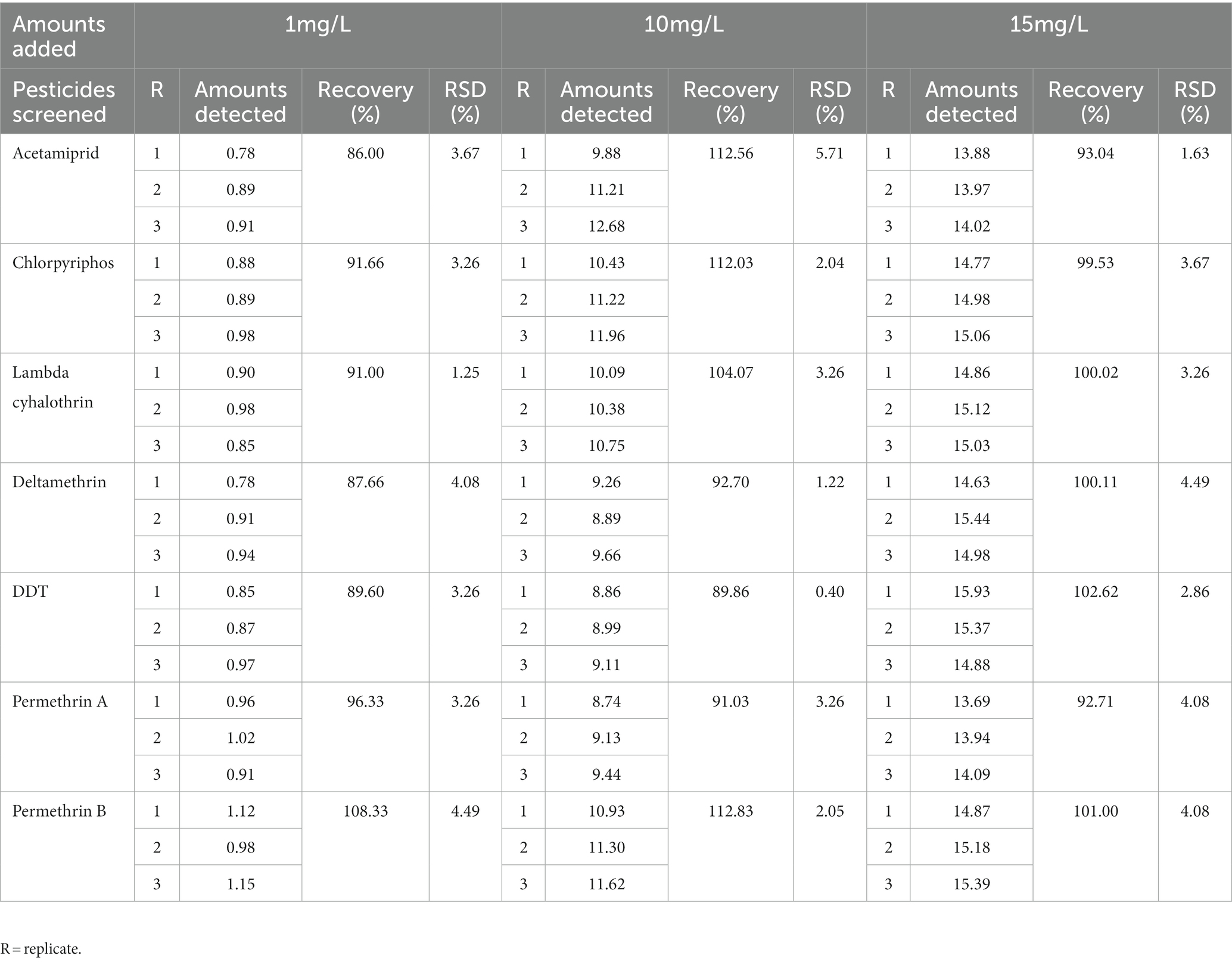- 1International Livestock Research Institute, Dakar, Senegal
- 2International Institute of Tropical Agriculture, Abomey-Calavi, Benin
- 3International Livestock Research Institute, Ouagadougou, Burkina Faso
- 4National Institute of Statistics and Demography, Ouagadougou, Burkina Faso
- 5International Livestock Research Institute, Addis Ababa, Ethiopia
- 6International Livestock Research Institute, Nairobi, Kenya
- 7Natural Resources Institute, University of Greenwich, Chatham, United Kingdom
Introduction: “What people worry about, and what makes them sick and kills them, are not the same” is maxim for risk communication experts. In Burkina Faso, pesticides are used by vegetable producers to improve productivity. However, consumer concern over pesticide use is high. Of course, if over-used pesticides could have serious health consequences for producers and consumers and also cause ecological damage.
Methods: A cross-sectional survey was conducted to detect and quantify the levels of residues of pesticides in tomatoes sold in urban markets of Ouagadougou. Two samples were collected from each vendor (n = 328 vendors) making a total of 656 tomato samples from 26 markets. Samples were subjected to High-Performance Liquid Chromatography (HPLC) for detection and quantification of six pesticide residues commonly used in West Africa including acetamiprid, chlorpyrifos, lambda-cyhalothrin, deltamethrin, dichlorodiphenyltrichloroethane (DDT), and permethrin.
Results: Overall, 62.2% of tomato samples contained at least one pesticide residue including acetamiprid, chlorpyrifos, lambda-cyhalothrin and DDT. Deltamethrin and permethrin were however not detected in any samples. The highest proportions of samples were contaminated with DDT (32.9, 95%CI: 27.9–38.3%), followed by acetamiprid (31.1, 95%CI: 26.2–36.5%), lambda-cyhalothrin (28.4, 95%CI: 23.6–33.6%) and chlorpyrifos (10.7, 95%CI, 7.6–14.6%). 21.3% of samples exceeded Codex Alimentarius Commission (CAC) Maximum Residue Levels (MRLs) including Acetamiprid (13.1%), DDT (7.3%), lambda-cyhalothrin (2.1%) and chlorpyrifos (0.3%); while 61.3% of sample exceeded European Union (EU) MRLs. Multiple pesticide residues (up to 4) were detected simultaneously in 27.7% of the total samples.
Conclusion: The study suggests that producers and consumers may be exposed to pesticides that can be highly toxic to them and to the environment. We recommend further quantitative risk assessment for consumer exposure and identification of best procedures to reduce residues in vegetables. Meanwhile, monitoring and regulating pesticide use, with the promotion of good agricultural practices, are warranted to prevent consumers, producers and environmental exposure. However, given this may not be effective, promotion of consumer washing and peeling of vegetables may be warranted to at least empower consumers to protect themselves. Moreover, where resources are scarce they should be directed to the highest burden hazards and in Burkina Faso, these are not likely to be pesticides.
Introduction
The vegetable sector plays an important role in the socio-economic development of Burkina Faso. The sector employs many women and youths, and provides an affordable source of nutritious foods widely sold in informal, urban food markets (FAO, 2007). Most vegetables produced locally (tomatoes, onions, cabbage, etc.) are produced for domestic consumption. They are recommended to be eaten fresh, unpeeled, and unprocessed to avoid loss of their high nutritional value and the minerals, vitamins, fibers, and antioxidants they contain (WHO, 2004).
The group of substances known as pesticides includes insecticides, fungicides, herbicides, rodenticides, molluscicides, and nematicides (Bernardes et al., 2015). Pesticides play an important role in agricultural development because they reduce losses and unit cost of production of agricultural products, and improve product quality (Aktar et al., 2009; Fenik et al., 2011). They are considered as the main component in protecting agricultural products in the field and during storage to maintain crop yield and quality (Damalas and Eleftherohorinos, 2011).
Despite these benefits, excessive use of pesticides on fruits and vegetables to protect them from damage and loss to pests increases pesticide residues in these foods (Grewal, 2017). After application on crops, pesticides residues tend to remain for a period whilst they degrade, not only in the plants but also in various environmental matrices, like water, soil or sediments (Malhat et al., 2016). They have been reported to cause toxic effects on humans, ranging from short-term effects such as headaches and nausea to chronic effects like cancer, reproductive damage and endocrine disruption (Malhat et al., 2015).
The main exposure route for humans is via contaminated food, with this route contributing five times more than other routes, such as air and drinking water (Claeys et al., 2011).
Farm workers applying pesticides obviously have especially high exposure risks. In Burkina Faso agriculture accounts for about 80% of the workforce, so the population risk via this route can be considerable (IFAD, 2023). Therefore, it is important to establish strategies to ensure the safe application of pesticides on farms and put in place procedures to reduce residues in food and feed.
During assessment of the vegetable value chains in Ouagadougou carried out within the project “Urban food markets in Africa: Incentivizing food safety using a pull-push approach” (ILRI, 2019), consumers in Ouagadougou were found to be very concerned about the safety of the vegetables sold in the markets, especially those consumed raw such as tomatoes. Consumers were particularly concerned about the potential health risks resulting from food contamination with agrochemicals, such as pesticides. Inappropriate use of pesticides on farm, poor practices at markets and lack of information of consumers on best practices for safely processing vegetables for home consumption were all raised as important issues by actors (Dione et al., 2021).
As well as impacting on human health, pesticides are toxic for a wide range of species of that are not the intended targets, including invertebrates and many vertebrates, especially fish (Pathak et al., 2022). The food security and livelihoods benefits arising from pesticides, coupled with their negative impacts on human, animal and ecological health, and the complexity of managing this trade-off make pesticides a true One Health issue.
However, there is a lack of empirical evidence to see if these consumer concerns towards potential pesticides residues in food are justified in Burkina Faso.
Therefore, the aim of this study was to assess the level of contamination of tomatoes sold in urban markets of Ouagadougou by common pesticides used in vegetable farming in West Africa. This information could then be used to assess health and environmental risks and indicate what future action is needed.
Materials and methods
Sampling of markets and tomato vendors
The tomato sample collection was carried out between 02nd and 11th June 2022 in the commune of Ouagadougou, the capital city of Burkina Faso. A total of 26 vegetable markets were randomly sampled from a list of 100 vegetable markets in the city obtained through a census supplemented by official records (Figures 1, 2). In total, 328 vendors were selected from the markets based on their willingness to participate (Table 1).
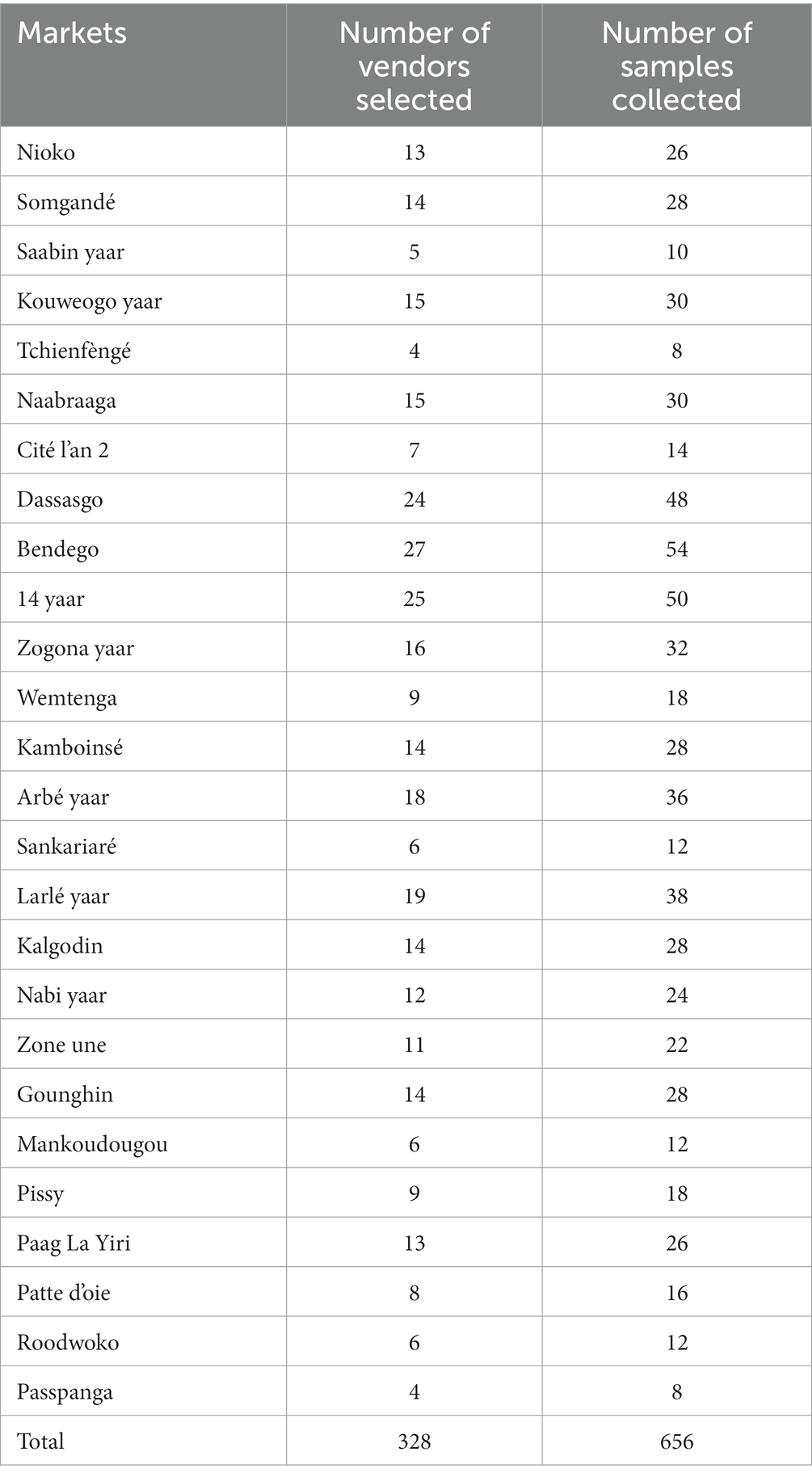
Table 1. List of selected markets with number of tomato vendors and tomato samples collected in each market.
Tomato sample collection
A total of 656 tomato samples were collected, with two samples per tomato retailer (Table 1) and each sample weighed 1 kg. The retailer selected the tomatoes as for a normal customer and was not aware that the samples were collected as part of a study (Figure 1). Each sample was wrapped with aluminum foil, labelled, then placed in a zip-lock bag and stored in an ice box containing ice packs. Each tomato sample was carefully crushed using a blinder. Twenty to 30 grammes of each crushed sample (average particle size distribution ≤80 μm, using sieve analysis method) (Surak et al., 1979) were taken in triplicates and each replicate was transferred into a 50 mL flacon tube and the whole was stored in a freezer at −4°C until processed.
Selection criteria for the pesticides screened
The pesticides screened in this study included Lambda cyhalothrin, deltamethrin, permethrin, DDT, chlorpyrifos and acetamiprid. The choice of these pesticides was based on own experience of their use in West Africa and their frequent testing in agricultural products in the laboratory where the work was implemented, which is a reference laboratory in west Africa. We also carried out literature review on these pesticides to make sure that they also had a public health implication.
The first three insecticides, (lambda cyhalothrin, deltamethrin, and permethrin), belong to the class of pyrethroids. These pesticides are widely used in human health, animal health and agriculture because of their high efficiency and especially their low persistence in nature (Barberá, 1974; Hardstone et al., 2007; Shinger et al., 2012). They are easily degraded by sunlight and the atmosphere between one to two days after application to crops (Sur et al., 2000). For these various reasons, they were chosen as part of our study. As for DDT, it quickly became the most widely used modern pesticide in all fields including agriculture, human and animal health since 1950s. But about 10 years later, it was banned in most countries because of its proven toxicity to health and the environment. In addition, due to its high persistence, its traces can still be found in the soil for many years (Fellenberg, 2000). This is why it was important to screen it. Chlorpyrifos is a pesticide of the organophosphate class widely used in agriculture especially in the cultivation of fruits and vegetables (Koshlukova and Reed, 2014). This pesticide is particularly known for its toxicity to the brain development of fetuses and young children (Cometa et al., 2007). Recently classified as a persistent pesticide, chlorpyrifos has been banned in Canada and the European Union since April 2020. Acetamiprid is an pesticide of the neonicotinoid family widely used in agriculture for the prevention and control of hemiptera harmful to plants (cereals, vegetables and cotton) and fruit trees (Pan et al., 2022). This pesticide is known for its low toxicity and high ability to adhere to surfaces. Its effect is rapid and persistent. Its wide usage by market gardeners justified its choice.
Chemicals and reagents for laboratory analysis
Samples were transported to the Chemistry Laboratory of the International Institute of Tropical Agriculture (IITA), Cotonou, Benin for analysis. Acetonitrile (ACN) 98% (HPLC grade) is from Thermo Fisher Scientific (Loughborough, United Kingdom). Analytical standards of λ-cyhalothrin (CAS: 91465–08-6), Chlorpyrifos (CAS:5598-13-0), Deltamethrin (CAS:52918–63-5), Permethrin (CAS:52645–53-1) and Acetamiprid (CAS:135410–20-7) of purity ≥98% were obtained from Sigma-Aldrich, (Buchs, Switzerland), while DDT 99.5% was supplied from Chem Service (Pennsylvania, United States). MgSO4 99% and CH3COONa 98% were purchased from Sigma-Aldrich (St Louis, United States), while formic acid was obtained from Park Scientific (Northampton, United Kingdom).
Instrumentation and chromatographic condition
Liquid chromatography was performed using an Agilent 1100/1200 Series HPLC instrument, equipped with a Quaternary pump, a vacuum Degasser, a G1313A Autosampler, a temperature-controlled column compartment and an UV–VIS/ Diode Array Detector. The separation of the analytes was achieved on an AcclaimTM 120-C18 column (4.6 × 250 mm, 5 μm, Thermo Scientific Germany). The integrated data were recorded using Agilent G2170AA software operating on a computer system. The mobile phase consisted of the mixture of water and acetonitrile, respectively, at 15 and 85% in isocratic elution with a flow rate at 1 mL/min. All solvents were filtered through a 0.45 μm nitrocellulose filter before use. The column temperature was kept at 28°C and the autosampler temperature was also maintained at 28°C with an injection volume of 20 μL. The detection wavelengths were set at 226, 232 and 245 nm with a total run time of 25 min.
Preparation of calibration standard and sample analysis
Stock solutions (1,000 mg/L) of acetamiprid, chlorpyriphos, lambda cyhalothrin, deltamethrin, DDT and permethrin were prepared by dissolving 1 mg of each powder in 1 mL of acetonitrile. Each mother solution was then diluted to prepare 500 μL of each of the following concentrations: 3.75, 7.5, 15, 30, 60 and 120 mg/L. Fifty microliter of each obtained solution of pesticide at the same concentration were then mixed to obtain 300 μL, corresponding to 0.625, 1.25, 2.5, 5, 10, and 20 mg/L, respectively. From the obtained standard solutions, calibration curves were plotted as a function of peak areas generated from the chromatogram against concentrations of each pesticide standard. The linearity was expressed using the correlation coefficient (R2-value) and intercept value. The obtained regression equations were helpful in the determination of residual concentrations of screened pesticides present in the tomato samples. In addition, the obtained linear regression lead to the determination of both Limit of Detection (LOD) and Limit of Quantification (LOQ) of each screened pesticide. LOD and LOQ were estimated using 3S/m and 10S/m respectively, where S is the standard deviation of the intercept and m is the slope of the regression line. The pesticide identification was obtained by comparing the recorded chromatograms on each tomato sample to that of the standard of the screened pesticides.
Sample extraction and clean-up
Before the HPLC analysis, samples were pre-treated to start the process of extraction of residues. The procedure used for the sample extraction and clean-up was adapted from the QuEChERS (quick, easy, cheap, effective, rugged, and safe) method (Jahanmard et al., 2016). Briefly, 5 g of crushed tomato were introduced into 50 mL centrifuge tube, 5 mL of acetonitrile (1% formic acid) and were added, and the mixture stirred vigorously for 10 min using a mechanical shaker to ensure complete mixing. A salt mixture containing 2 g of Magnesium sulfate (MgSO4) and 0.5 g of Sodium acetate (NaOAc) were added, and the mixture was shaken again for 1 min, then centrifuged at 5000 revolution per minute for 5 min. To avoid co-extracted compounds which may negatively affect the analysis, 1 mL of the supernatant was pipetted and transferred into the clean-up tube containing 150 mg magnesium sulphate, 50 mg primary secondary amine (PSA) and 50 mg Octyldecylsilane (C18). The mixture was shaken again for 1 min and then centrifugated for 5 min at 5,000 rpm. Then, 100 μL of the supernatant was pipetted, filtrated using 0.2 μm filter polytetrafluoroethylene chromanol and then transferred into vials for HPLC analysis.
Method validation
The validation of the analytical method consisted of investigating its reliability, accuracy and precision. In the present study, the proposed method was first validated before its applicability to the determination of pesticide residues in tomato samples. Thus, reliability of the method was evaluated by spiking some tomato samples with standard dilutions and estimating the recovery values. Then, three random samples of tomato were washed many times with distilled water, crushed and then spiked with known amounts (1.5 and 15 mg/L) of the standards of tested pesticides. A sample without standard pesticides was used as control. All samples underwent the extraction process using the QuEChERS method as previously described, and finally analyzed using HPLC. The accuracy of the method was estimated by the relative standard deviation percent (RSD%), while the precision was calculated using the repeatability test by injecting three replicates of different concentrations of the sample.
Statistical analysis
The average concentration of pesticide residues from the two samples of tomatoes collected from the same retailer was calculated to correct for the non-independence of collecting two samples from each stall. As there was little variation between samples from the same stall, this did not mask extreme values that could be particularly risky. Therefore, statistical analysis was then performed with 328 mean values. The concentration of pesticide residues was transformed into log using log10(x + 1) to improve the normality of the distribution of our data. Residual concentration of a specific pesticide in tomato sample was compared with its Codex Alimentarius Commission (CAC) and European Union (EU) Maximum Residue Limits (MRLs) in tomato but when a specific pesticide was not indicated residual values were compared with a general default MRL of 10 μg/kg (0.01 mg/kg) for EU MRL and 2000 μg/kg (2 mg/kg) for CAC. Statistical analysis was performed using RStudio-2022.07.2–576. A map of study site was created using using QGIS.
Results
Calibration curve
HPLC technique was performed to investigate the relationship between the peak area and concentrations of the pesticides. Thus, the calibration curves were obtained by plotting the peak areas against concentrations of each tested pesticide over the range from 0.625 mg/L to 20 mg/mL. The obtained results are shown in Figure 3.
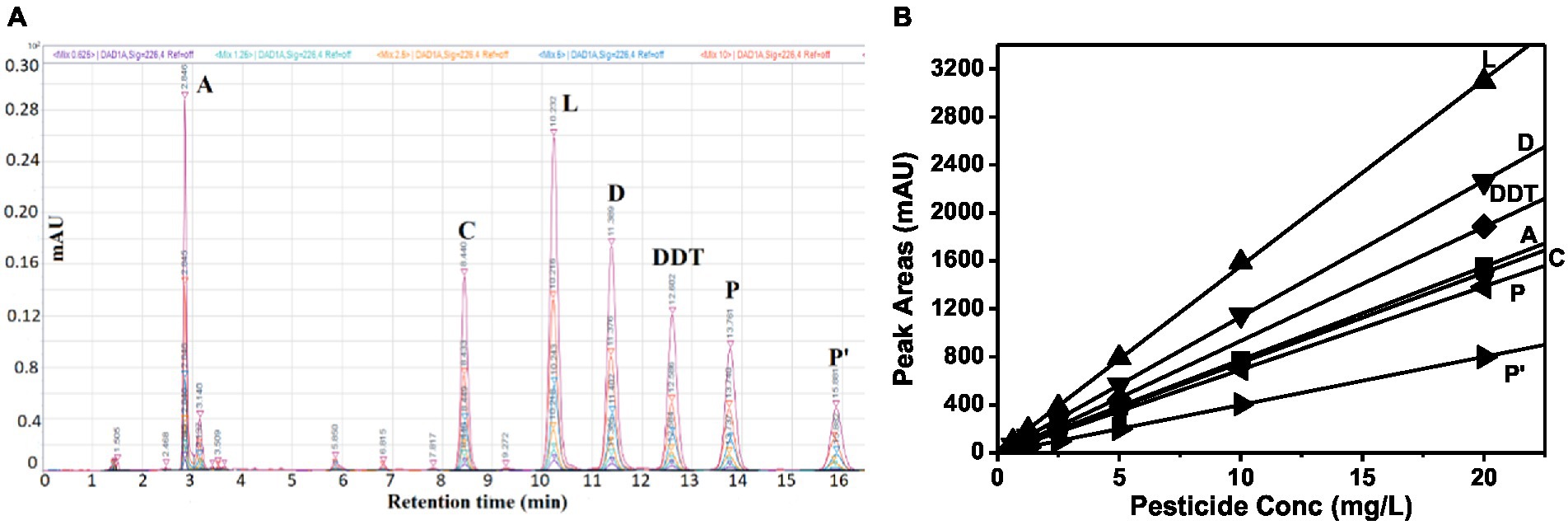
Figure 3. (A) Chromatogram curves of Acetamiprid, Chlorpyrifos, λ-cyhalothrin, Deltamethrin, DDT, and Permethrin (P and P′), and (B) Shows the corresponding calibration curves.
From Figure 3, peak areas increased and were proportional to each concentration of screened pesticides. The obtained regression equations and correlation coefficients (R2) showed good fitness of the model (Table 2). The limit of detection and limit of quantification for each screened pesticide were calculated, respectively, using the formulas 3S/m and 10S/m, where S represents the standard deviation and m the slope. The Table 2 presents the summary of the obtained results.

Table 2. Correlation coefficients, regression equations, relative standard deviations (RSD, n = 3), LOD and LOQ for the six screened pesticides.
Validation of laboratory tests
The recovery and relative standard deviation percentages of the elaborated method are summarized in Table 3. All the experiments were carried out three times under the same conditions. Recovery values for the screened pesticides in tomato samples were in the range from 85 to 118%, which is in the acceptable range (60–140%), recommended by the EU guidelines. In addition, the relative standard deviations (RSD) obtained for peak areas of the screened pesticides were below 6%, indicating that the obtained area sets were closer and were scattered from 2 to 6% around the mean. The acceptable range for RSD is ±20% according to the EU guidelines. These results clearly demonstrate that the proposed method was effective and reliable for pesticides detection in these samples.
Pesticide residues concentration and prevalence in tomato samples
Of the 328 samples of tomatoes, 62.2% (204/328, 95% CI, 56.7–67.4%) contained at least one detectable pesticide. Of all pesticides detected, acetamiprid had the highest mean concentration of 0.66 (0.50–0.82) mg/L, followed by DDT with 0.58 (0.44–0.73) mg/L, lambda-cyhalothrin with 0.24 (0.17–0.31) mg/L and to a lesser extent chlorpyrifos with only 0.04 (0.02–0.06) mg/L (Figure 4). However, deltamethrin and permethrin were not detected in any of the samples. Approximately 61.3% (201/328, 95% CI, 55.7–66.5%) of the samples had pesticide residue concentration above EU MRLs. This rate goes down to 21.3% (70/328, 95% CI, 17.1–26.3%) when compared with CAC MRLs. DDT had the highest proportion of samples in which concentration of pesticide residues exceeded EU MRL followed by acetamiprid, lambda-cyhalothrin and chlorpyrifos. While acetamiprid had the highest proportion of samples in which concentration of pesticide residues exceeded CAC MRL, followed by DDT then lambda-cyhalothrin then chlorpyrifos (Table 4).
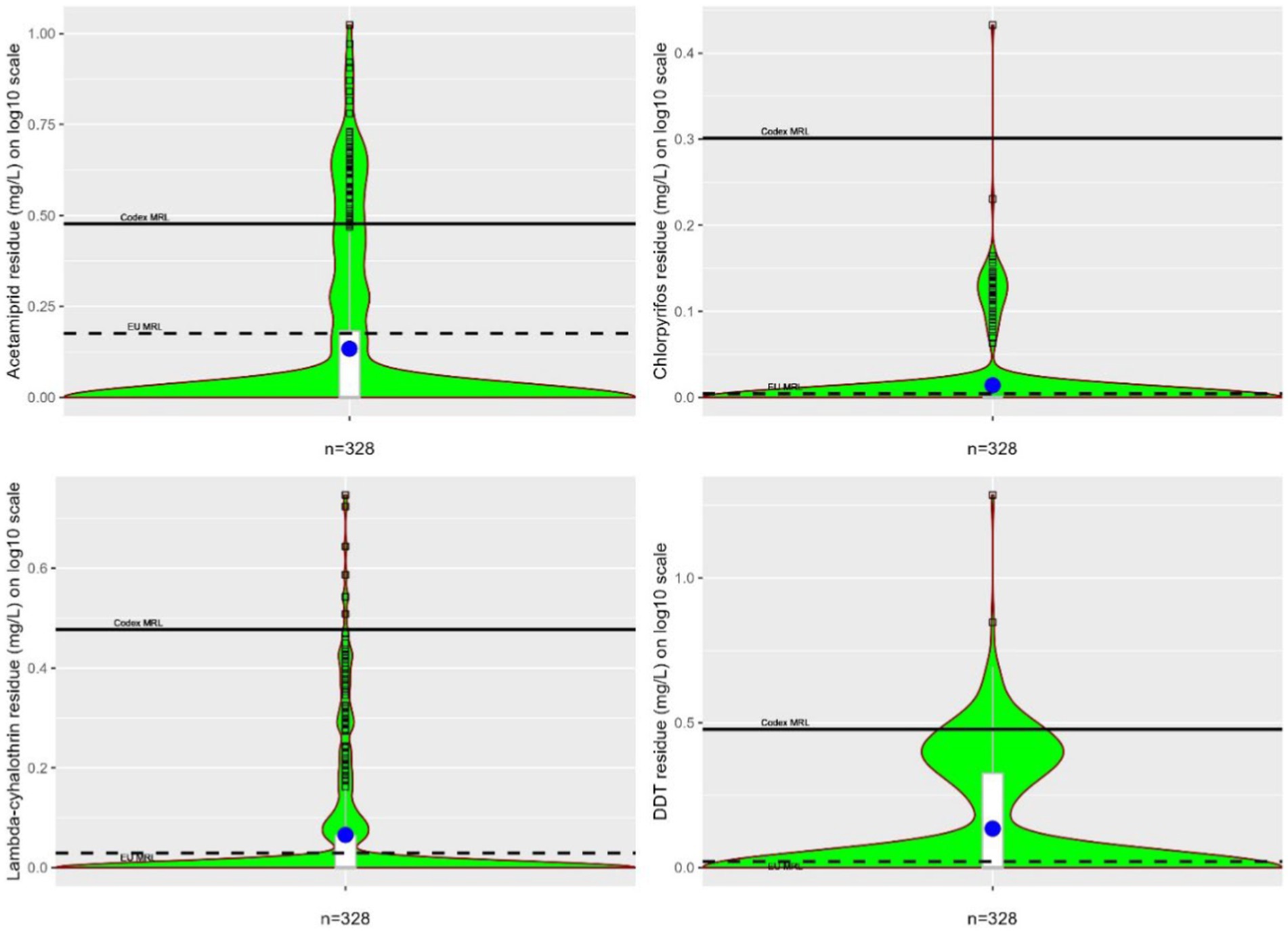
Figure 4. Violin chart showing comparison of pesticide residue levels (mg/l) at log10(x + 1) scale in tomatoes samples for acetamiprid (top-left), chlorpyrifos (top-right), lambda-cyhalothrin (bottom-left) and DDT (bottom-right). Blue dots indicate the average concentration of pesticide residues in tomatoes and black dots indicate outliers. The horizontal dotted and solid lines indicate the EU and CAC MRLs (mg/L), respectively.

Table 4. Percentage of tomato samples with pesticide residues and those with residue levels above EU and CAC MRLs.
Multiple residues in tomato samples
Overall, 27.7% of the total samples had two or more pesticide residues with 17.4% (57/328, 95% CI, 13.5–22.0%), 7.6% (25/328, 95% CI, 5.1–11.2%), and 2.7% (9/328, 95% CI, 1.3–5.3%) of the samples being contaminated with two, three and four pesticides, respectively (Figure 5). The two pesticides concomitantly detected in a single sample were acetamiprid + lambda-cyhalothrin (25.3%), lambda-cyhalothrin + DDT (25.8%), chlorpyrifos + DDT (17.2%), acetamiprid + DDT (17.2%), chlorpyrifos + lambda-cyhalothrin (8.6%), and acetamiprid + chlorpyrifos (5.9%). Whereas the three pesticides concomitantly detected in a single sample were acetamiprid + lambda-cyhalothrin + DDT (41.0%), chlorpyrifos + lambda-cyhalothrin + DDT (26.2%), acetamiprid + chlorpyrifos + DDT (18.0%) and an acetamiprid + chlorpyrifos + lambda-cyhalothrin (14.8%). Finally, four pesticides concomitantly detected in nine samples (2.7%).
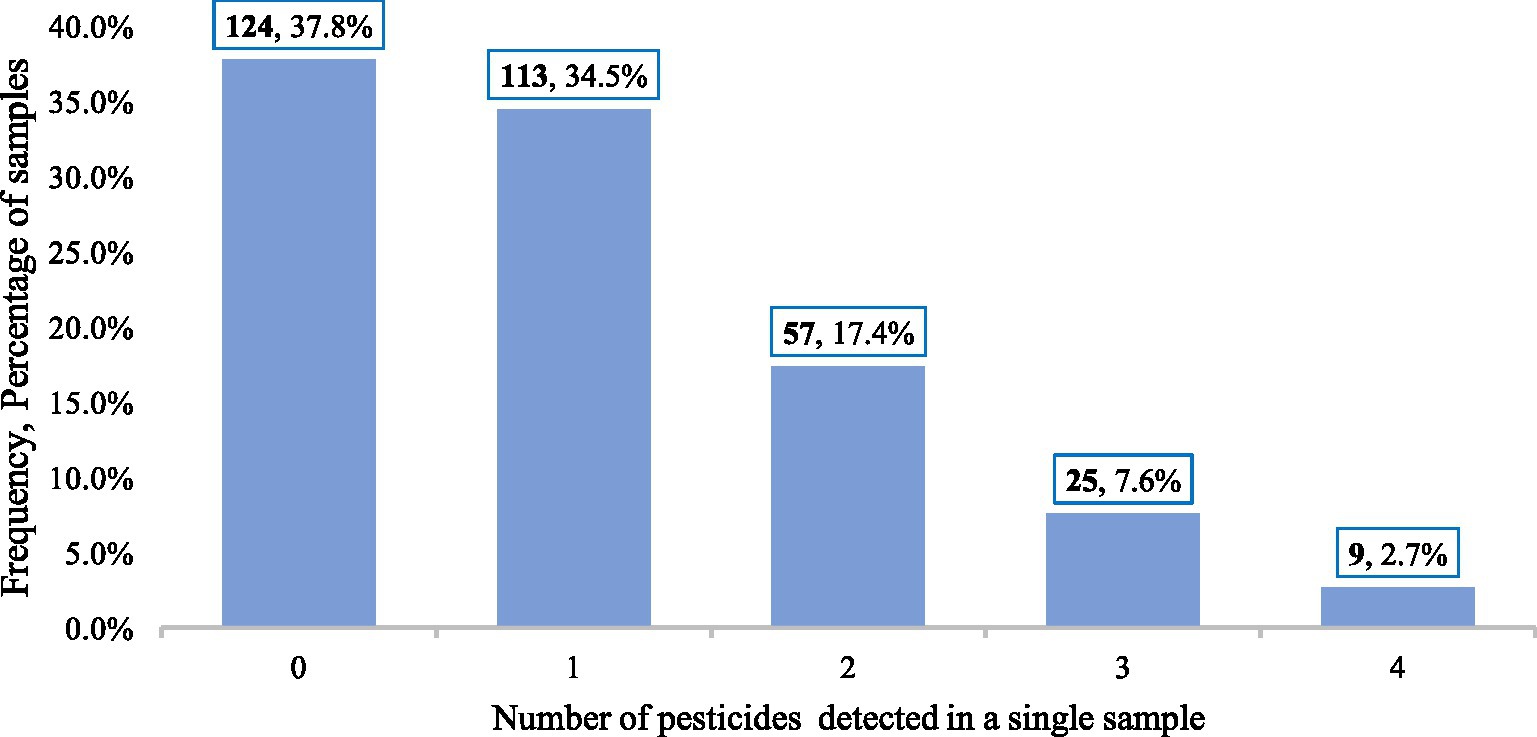
Figure 5. Number of pesticides found in a single tomato sample (n = 328) and percentage of samples with the number of pesticides detected.
Discussion
Pesticides have been used by producers to control insects and other agricultural pests, resulting in remarkable increases in agricultural production. Without the use of pesticides, there would be a 78% loss of fruit production, a 54% loss of vegetable production, and a 32% loss of cereal production (Tudi et al., 2021). However, the inappropriate use of pesticides in agriculture may result in many health problems for producers and consumers who are exposed through their handling practices (Nisha et al., 2021; Parven et al., 2021). The overall rate of pesticide contamination for tomatoes in our study (62.2%) is very high. Most pesticides have their concentration above the EU and below the CAC MRLs. Here we consider the CAC MRLs as more relevant as a global standard rather than the more cautious EU standard. Pesticides detected above the CAC MRLs were acetamiprid, lambda-cyhalothrin, chlorpyrifos and DDT. Chlorpyrifos is proven to be highly toxic to human health (Cometa et al., 2007)while DDT is highly toxic to health and the environment, (Hardstone et al., 2007).
In a study carried out earlier in Burkina Faso in 2018, pesticide residues found in tomato samples included lambda-cyhalothrin, profenofos and chlorpyrifos-ethyl. However, only concentration of chlorpyrifos-ethyl was found above MRLs, and the risk of acute poisoning for consumers was estimated to be low based on predicted short-term dose calculations (Son, 2018). Elsewhere, there have been many studies on pesticide residues in tomatoes. This is the case for Tanzania whereas study reported 96% of tomatoes to be contaminated with pesticide residues including chlorpyrifos, with 41.8% of samples above EU MRLs (Mahugija et al., 2017). This is much higher than what we found in our study (10.7%). Acetamiprid and chlorpyrifos were frequently detected in tomatoes in Northern and Western regions of India (Tripathy et al., 2022). Acetamiprid and DDT showed the highest concentrations of pesticides found in our samples, suggest that these pesticides might have been applied inappropriately by producers.
During the application of pesticides on farms, factors such as frequency of application, equipment, mixer conditions and exposure, determine the potential chemical risks to human health (MacLachlan and Hamilton, 2010). On farm use of pesticides and other chemicals have been reported to be suboptimal in Burkina Faso. Producers did not observe any adequate protective measures during handling of pesticides on vegetables and compliance with withdrawal periods prior to harvest was poor (Son et al., 2017). Observation of withdrawal period on-farm is important to reduce the risk to human consumption. This was confirmed by a study of Malhat et al. (2016) who reported that tomatoes treated with lambda-cyhalothrin could be considered safe for human consumption 14 days after application of the pesticide at the recommended dose.
Foods with residue levels for pesticides below MRLs may be considered safe for consumers (WHO, 2011), but MRLs are not always a safe limit as foods with residues above MRLs may still be safe for consumption (AFSA, 2009). However, without an active regulatory body monitoring pesticides residues in food, as it is the case for Burkina Faso, it is difficult to give accurate advice to consumers whether to consume or not food contaminated with pesticide residues regardless the level of contamination.
While a pesticide with a high acute toxicity is fatal, even if only a tiny quantity can be absorbed into the body (Pathak et al., 2022),exceeding MRLs can restrict access to international export markets, hence requiring government authorities to monitor and enforce compliance with MRLs. Pesticide can also affect the nutritional value of food as Abrokwah et al. (2019) reported that both acetamiprid and lambda-cyhalotrhin application to tomato and onion can cause disruption in biochemical content. Most of the effects of acetamiprid and lambda-cyhalothrin on the parameters studied were observed at or above the recommended dose treated samples of tomatoes. This shows the potential impact of residues on human and animal nutrition.
Many samples had multiple residues concomitantly ranging from two to four pesticides. The contamination with multiple classes of pesticides is of concern because toxicity can occur at lower levels of exposure and toxicity is more unpredictable when exposed to more than one class of pesticides at the same time (Reffstrup et al., 2010). In addition, combinations of pesticides, especially if they contain an insecticide, usually increase the toxic effect of the components, or even multiply it by a hundred (Thompson, 1996).
Tomato traders and consumers of Ouagadougou are particularly concerned about the quality of vegetables they consume. Among common causes of poor-quality vegetables, they pointed out the irrational pesticides use of pesticides at the production level. As soon as the vegetables arrive at the market, they are off-loaded and stored, without washing or disinfecting, as this practice according to traders could accelerate rotting due to the risk of high residual humidity (Dione et al., 2021). This means that tomatoes do not undergo any process at market to reduce pesticide residues. This leaves it to the consumers to do the work at home prior to cooking. According to Amqam et al. (2019), the pesticides residue in tomatoes may be reduced through washing, as it is the case of chlorpyrifos under experimental conditions. Washing with non-toxic acidic solutions, ozonated water, and ultrasonic cleaning have been found to be more effective than washing with tap water (Tiryaki and Pola, 2022). However, the effectiveness of washing solutions differed for every type of pesticide when methomyl and acetamiprid residues from tomatoes were compared (Rasolonjatovo et al., 2017). This indicates the need for more customized studies to identify the best washing methods to reduce residues of each specific pesticide in tomatoes before consumption. On the other hand, given the prevailing practices in Burkina Faso expose producers and consumers to contamination, producers, traders and consumers need to be sensitized on the use of recommended and appropriate agro-chemicals and the risks associated with their use for crops and fruit, producers, consumers and the environment. Regulations should be enforced to improve quality control at market level. While consumers should be educated about proper hygiene and processing of tomatoes prior consuming.
The strengths of the study lies on the fact that this it is novel and it responds to the need of stakeholders of the food value chain, most importantly consumers who are concerned about the potential risk related to bad practices adopted by producers on the use of pesticides on vegetable gardens. The markets visited are the main locations where consumers of Ougadougou purchase vegetables, hence the results fit for purpose. However, the study focused on detection and quantification, but the risk to consumers was not evaluated. The results should be interpreted carefully, and considered as a first step toward a more comprehensive assessment of the risk and burden of pesticides containing tomatoes, as well as other chemicals and biological contaminants of food in Burkina Faso.
This study found widespread pesticide residues in tomato samples, contaminated with one or more types of pesticides, mainly acetamiprid, chlorpyrifos lambda-cyhalothrin and DDT. Most pesticide residue levels found in the tomato samples exceeded the EU and a quarter were contaminated above CAC MRLs. There is the need to carry out further investigations to look at how these findings relate to risk to the consumer. We recommend tighter monitoring of farming practices, identifying interventions to manage these risks at market or household level. Increasing awareness of the risks to vegetable producers, traders and consumers on the risk associated with poor practices at all nodes of the value chain.
Data availability statement
The raw data supporting the conclusions of this article will be made available by the authors, without undue reservation.
Ethics statement
Ethics approval was granted for this study by ILRI’s Institutional Research Ethics Committee (approval number: ILRI-IREC2019-36/1). While collecting vegetable samples from retailer markets, we did not collect information on vegetable stalls that could identify them and raise privacy issues. We obtained oral consent from vegetable producers to collect vegetable samples from their farms, analyzing the survey data anonymously.
Author contributions
MMD and TK-J: conceptualization of study. MMD, GSI, TK-J, RD, and SFM: development of research tools. GSI and SFM: data collection. SFM and RD: laboratory processing. AAO, DM, and TK-J: statistical analysis. GD, KR, and DG: strategic review strategic review. MMD and GSI: administration and coordination. All authors contributed to the article and approved the submitted version.
Funding
This work was supported by the Bill & Melinda Gates Foundation (INV-008430 OPP1195588). Under the grant conditions of the Bill & Melinda Gates Foundation, a Creative Commons Attribution 4.0 Generic License has already been assigned to the Author Accepted Manuscript version that might arise from this submission. The work was also supported by the German Federal Ministry for Economic Cooperation and Development (BMZ) through the One Health Research, Education and Outreach Centre in Africa (OHRECA) led by ILRI. Support was also provided by the Foreign, Commonwealth and Development Office (FCDO) of the UK Government.
Acknowledgments
The authors special thanks go to the people who participated in the study in data collection and in sharing their expertise and experience with us. The authors would like to extend our acknowledgements to the International Institute of Tropical Agriculture (IITA) Laboratory Services staff for their collaboration during laboratory analysis of our study samples.
Conflict of interest
The authors declare that the research was conducted in the absence of any commercial or financial relationships that could be construed as a potential conflict of interest.
Publisher’s note
All claims expressed in this article are solely those of the authors and do not necessarily represent those of their affiliated organizations, or those of the publisher, the editors and the reviewers. Any product that may be evaluated in this article, or claim that may be made by its manufacturer, is not guaranteed or endorsed by the publisher.
References
Abrokwah, F. K., Matthew, M., Danso, P. C., and Affoh, A. A. (2019). Study on the effects of Acetamiprid and lambda-Cyhalothrin application on some biochemical parameters of onion and tomato. Int. Res. J. Food Nutr. 12, 7237–7252. doi: 10.1039/d1ra09440h
AFSA (2009). The 2009 European Union report on pesticide residues in Food1European food safety authority. European food safety authority (EFSA), Parma, Italy. EFSA journal 0 9, 2430. doi: 10.2903/j.efsa.2011.2430,
Aktar, M. W., Paramasivam, M., Sengupta, D., Purkait, S., Ganguly, M., and Banerjee, S. (2009). Impact assessment of pesticide residues in fish of ganga river around Kolkata in West Bengal. Environ. Monit. Assess. 157, 97–104. doi: 10.1007/s10661-008-0518-9
Amqam, H., Ane, R.L., Manynyulei, S., Stang, S., Rahim, M.R., Novianti, P.R., et al. (2019). Chlorpyrifos residue in washed and unwashed tomatoes. Conference: Proceedings of the 3rd International Conference on Environmental Risks and Public Health, ICER-PH 2018, 26–27, Makassar, Indonesia.
Bernardes, M., Pazin, M., Pereira, L., and Dorta, D. (2015). Impact of Pesticides on Environmental and Human Health. In Toxicology Studies - Cells, Drugs and Environment. InTech. doi: 10.5772/59710
Claeys, W. L., Schmit, J.-F., Bragard, C., Maghuin-Rogister, G., Pussemier, L., and Schiffers, B. (2011). Exposure of several Belgian consumer groups to pesticide residues through fresh fruit and vegetable consumption. Food Control 22, 508–516. doi: 10.1016/j.foodcont.2010.09.037
Cometa, M. F., Buratti, F. M., Fortuna, S., Lorenzini, P., Volpe, M. T., Parisi, L., et al. (2007). Cholinesterase inhibition and alterations of hepatic metabolism by oral acute and repeated chlorpyrifos administration to mice. Toxicology 234, 90–102. doi: 10.1016/j.tox.2007.02.008
Damalas, C. A., and Eleftherohorinos, I. G. (2011). Pesticide exposure, safety issues, and risk assessment indicators. Int. J. Environ. Res. Public Health 8, 1402–1419. doi: 10.3390/ijerph8051402
Dione, M., Diarra, S., Ilboudo, G., Konkobo-Yameogo, C., Lallogo, V.R., Roesel, K., et al. (2021). Value chain assessment of animal-source foods and vegetables in Ouagadougou, Burkina Faso–considering food safety, quality and hygiene perceptions and practices. ILRI Research Report 87. Nairobi, Kenya: ILRI.
Fellenberg, G. (2000). Available at: https://agris.fao.org/agrissearch/search.do?recordID=XF2016010622.
Fenik, J., Tankiewicz, M., and Biziuk, M. (2011). Properties and determination of pesticides in fruits and vegetables. TrAC Trends Anal. Chem. 30, 814–826. doi: 10.1016/j.trac.2011.02.008
Grewal, A. (2017). Pesticide res-idues in food grains, vegetables and fruits: a Hazard to human health. J. Med. Chem. Toxicol. 2, 1–7. doi: 10.15436/2575-808X.17.1355
Hardstone, M. C., Leichter, C., Harrington, L. C., Kasai, S., Tomita, T., and Scott, J. G. (2007). Cytochrome P450 monooxygenase-mediated permethrin resistance confers limited and larval specific cross-resistance in the southern house mosquito, Culex pipiens quinquefasciatus. Pest. Biochem. Physiol. 89, 175–184. doi: 10.1016/j.pestbp.2007.06.006
IFAD (2023). Burkina Faso. Available at: https://www.ifad.org/en/web/operations/w/country/burkina-faso (accessed 10th march 2023).
ILRI (2019). Urban food markets in Africa: Incentivizing food safety using a pull-push approach. Project inception report. Nairobi, Kenya: ILRI.
Jahanmard, E., Ansari, F., and Feizi, M. (2016). Evaluation of Quechers sample preparation and GC mass spectrometry method for the determination of 15 pesticide residues in tomatoes used in salad production plants. Iran. J. Public Health 45, 230–238.
Koshlukova, S. E., and Reed, N. A. (2014). Chlorpyrifos: encyclopedia of toxicology (third edition) 2014, 930–934. doi: 10.1016/B978-0-12-386454-3.00115-9,
MacLachlan, D. J., and Hamilton, D. (2010). Estimation methods for maximum residue limits for pesticides. Regul. Toxicol. Pharmacol. 58, 208–218. doi: 10.1016/j.yrtph.2010.05.012
Mahugija, J. A. M., Khamis, F. A., and Lugwisha, E. H. J. (2017). Assessment of pesticide residues in tomatoes and watermelons (fruits) from markets in Dar Es Salaam. Tanzania J. Appl. Sci. Environ. Manag. 21, 497–501. doi: 10.4314/jasem.v21i3.10
Malhat, F., Loutfy, N. M., and Ahmed, M. T. (2016). Dissipation pattern and risk assessment of the synthetic pyrethroid lambda-cyhalothrin applied on tomatoes under dryland conditions, a case study. Int. J. Food Contam 3, 1–7. doi: 10.1186/s40550-016-0029-3
Malhat, F., Watanabe, H., and Youssef, A. (2015). Degradation profile and safety evaluation of methomyl residues in tomato and soil. Hell. Plant Prot. J. 8, 55–62. doi: 10.1515/hppj-2015-0008
Nisha, U. S., Khan, M. S., Prodhan, M. D., Meftaul, I. M., Begum, N., Parven, A., et al. (2021). Quantification of pesticide residues in fresh vegetables available in local Markets for Human Consumption and the associated health risks. Agronomy 11:1804. doi: 10.3390/agronomy11091804
Pan, C., Yu, J., Yao, Q., Lin, N., Lu, Z., Zhang, Y., et al. (2022). Prenatal neonicotinoid insecticides exposure, oxidative stress, and birth outcomes. Environ. Int. 163:107180. doi: 10.1016/j.envint.2022.107180
Parven, A., Khan, M. S. I., Prodhan, M. D. H., Venkateswarlu, K., Megharaj, M., and Meftaul, I. M. (2021). Human health risk assessment through quantitative screening of insecticide residues in two green beans to ensure food safety. J. Food Compost. Anal. 103:104121. doi: 10.1016/j.jfca.2021.104121
Pathak, V. M., Verma, V. K., Rawat, B. S., Kaur, B., Babu, N., Sharma, A., et al. (2022). Current status of pesticide effects on environment, human health and it’s eco-friendly management as bioremediation: a comprehensive review. Front. Microbiol. 13:962619. doi: 10.3389/fmicb.2022.962619
Rasolonjatovo, M. A., Cemek, M., Cengiz, M. F., Ortaç, D., Konuk, H. B., et al. (2017). Reduction of methomyl and acetamiprid residues from tomatoes after various household washing solutions. Int. J. Food Prop. 20, 2748–2759. doi: 10.1080/10942912.2016.1250099
Reffstrup, T. K., Larsen, J. C., and Meyer, O. (2010). 2010. Risk assessment of mixtures of pesticides. Current approaches and future strategies. Regul. Toxicol. Pharmacol. 56, 174–192. doi: 10.1016/j.yrtph.2009.09.013
Shinger, M. I., Elbashir, A. A., Ahmed, H. E., and Aboul-Enein, H. Y. (2012). 2012. Simultaneous determination of cypermethrin and fenvalerate residues in tomato by gas chromatography and their applications to kinetic studies after field treatment. Biomed. Chromatogr. Biomed. Chromatogr. 26, 589–593. doi: 10.1002/bmc.1679
Son, D. (2018). Analyse des risques liés à l’emploi des pesticides et mesure de la performance de la lutte intégrée en culture de tomate au Burkina Faso (Thèse de doctorat). Université de Liège, Gembloux Agro-Bio Tech, Belgique (234 pages, 39 Figures, 33 Tableaux).
Son, D., Somda, I., Legreve, A., and Schiffers, B. (2017). Pratiques phytosanitaires des producteurs de tomates du Burkina Faso et risques pour la santé et l’environnement. Cah. Agric. 26:25005. doi: 10.1051/cagri/2017010
Sur, N., Pal, S., Banerjee, H., Adityachaudhury, N., and Bhattacharyya, A. (2000). Photodegradation of fenarimol. Pest Manag. Sci. 56, 289–292. doi: 10.1002/(SICI)1526-4998(200003)56:3<289::AID-PS119>3.0.CO;2-F
Surak, G. J., Matthews, F. R., Wang, V., Padua, A. H., and Hamilton, M. R. (1979). Particle size distribution of commercial tomato juices. Proc. Fla. State Hort. Soc. 92, 159–163.
Thompson, H. M. (1996). Interactions between pesticides; a review of reported effects and their implications for wildlife risk assessment. Ecotoxicology 5, 59–81. doi: 10.1007/BF00119047
Tiryaki, O., and Pola, B. (2022). Effects of washing treatments on pesticide residues in agricultural products Tarımsal ürünlerde yıkama işlemlerinin pestisit kalıntıları üzerine etkileri. J. Food Sci. Technol. 29, 1–11.
Tripathy, V., Sharma, K. K., Sharma, K., Gupta, R., Yadav, R., Singh, G., et al. (2022). Monitoring and dietary risk assessment of pesticide residues in brinjal, capsicum, tomato, and cucurbits grown in northern and Western regions of India. J. Food Compost. Anal. 110:104543. doi: 10.1016/j.jfca.2022.104543
Tudi, M., Daniel Ruan, H., Wang, L., Lyu, J., Sadler, R., Connell, D., et al. (2021). Agriculture development, pesticide application and its impact on the environment. Int. J. Environ. Res. Public Health. 2021;18:1112. doi: 10.3390/ijerph18031112
WHO (2004). Fruit and vegetables for health: Report of a joint FAO/WHO workshop, 1–3 2004, Kobe, Japan. World Health Organization and Food and Agriculture Organization of the UN.
Keywords: pesticide, tomato, food safety, market, Maximum Residue Levels
Citation: Dione MM, Djouaka R, Mbokou SF, Ilboudo GS, Ouedraogo AA, Dinede G, Roesel K, Grace D and Knight-Jones TJD (2023) Detection and quantification of pesticide residues in tomatoes sold in urban markets of Ouagadougou, Burkina Faso. Front. Sustain. Food Syst. 7:1213085. doi: 10.3389/fsufs.2023.1213085
Edited by:
Md Asaduzzaman, NSW Department of Primary Industries, AustraliaReviewed by:
Sirajul Islam Khan, Sher-e-Bangla Agricultural University, BangladeshK. M. Mohiuddin, Bangladesh Agricultural University, Bangladesh
Árpád Dr. Ambrus, National Food Chain Safety Office, Hungary
Copyright © 2023 Dione, Djouaka, Mbokou, Ilboudo, Ouedraogo, Dinede, Roesel, Grace and Knight-Jones. This is an open-access article distributed under the terms of the Creative Commons Attribution License (CC BY). The use, distribution or reproduction in other forums is permitted, provided the original author(s) and the copyright owner(s) are credited and that the original publication in this journal is cited, in accordance with accepted academic practice. No use, distribution or reproduction is permitted which does not comply with these terms.
*Correspondence: Michel Mainack Dione, bS5kaW9uZUBjZ2lhci5vcmc=
 Michel Mainack Dione
Michel Mainack Dione Rousseau Djouaka
Rousseau Djouaka Serge Foukmeniok Mbokou2
Serge Foukmeniok Mbokou2 Guy Sidwatta Ilboudo
Guy Sidwatta Ilboudo Kristina Roesel
Kristina Roesel Delia Grace
Delia Grace Theodore J. D. Knight-Jones
Theodore J. D. Knight-Jones